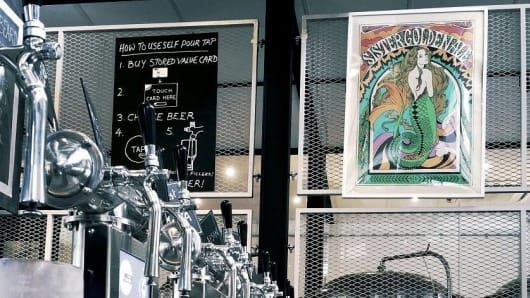Craft Singapore, the city-state’s first-ever craft beer festival, launches Friday in hopes of luring lager and ale guzzlers to more independent fare.
The festival comes on the heels of a global boom in craft breweries, also referred to as microbreweries, that has seen larger players acknowledging the competition. Anheuser-Busch InBev, the world’s largest brewer, announced purchases of three craft brewers in the month of December alone.
Microbreweries are broadly classified as small, independent operations producing limited volumes. In the U.S., annual production for an individual craft brewer is capped at 6 million barrels or less.
Singapore is home to around a dozen microbreweries, with four alone opening last year, Charles Guerrier, founder of CRAFT Singapore, told CNBC.
But the island nation’s most popular beer—in term of total volume sales—still remains Tiger, made by Heineken-owned Asia-Pacific Breweries (APB), according to Euromonitor.
Indeed, craft accounts for only around 2 percent of Singapore’s beer market share, noted Winston Kwang, owner of Beerstyle Distribution, a local company specializing in the import of American craft beers.
Industry observers highlighted a few factors behind the lower volumes.
 “We’re not yet at the stage where there’s strong demand for local craft beer. Unlike the U.K., where people get very territorial about their pints, Singapore has always latched onto foreign brands, but I’m sure we’ll be seeing more people apply national pride to beer in addition to their food,” explained Guerrier.
“We’re not yet at the stage where there’s strong demand for local craft beer. Unlike the U.K., where people get very territorial about their pints, Singapore has always latched onto foreign brands, but I’m sure we’ll be seeing more people apply national pride to beer in addition to their food,” explained Guerrier.
The widest range of craft beer available in the city-state is mainly imported from Belgium, with 6.92 million liters imported in 2014, Flemish government agency Flanders Investment and Trade said in a market report last year.
Moreover, the country’s tough regulatory environment doesn’t make it easy for local breweries, especially as capacity limits mean economies of scale are tough to achieve.
“It is quite difficult to operate here in Singapore as taxes are very high on alcohol and rents are very high. This has led to lots of multi-tap craft bars importing beers in from oversees,” noted Scott Robertson, brewmaster at Brewerkz, which has been operating in the country since 1997.
But things are starting to change.
In fact, APB—the nation’s leading brewer—has already joined the craft movement in an attempt to cash in on the global trend. APB owns Archipelago Brewery, a craft brewer that uses Asian flavorings such as lemongrass, tamarind and coriander.
When asked whether APB will expand its craft portfolio beyond Archipelago, the firm refused to comment.
Some believe commercial brewers may eventually snap up craft names in Asia, as has been the case in the U.S. and Europe.
“Of course, bigger players may eventually start buying smaller players here, it’s a likely trend,” said Steve Spinney, master brewer at Little Island Brewing Company, one of Singapore’s craft names.
The city-state can easily accommodate at least 20 microbreweries and when that happens, “big guys are not going to like it,” he said.
Others voiced a more cautious outlook.
“No matter how much craft beer grows, it’s not exponential growth that will unsettle the big boys,” said Kwang from Beerstyle Distribution.
Kwang, who has been in the industry for nearly a decade, believes none of Singapore’s craft brew pubs or breweries boast the branding or volume to warrant an acquisition now or over the next few years.
“The big boys would rather have their own craft brand instead,” he remarked.
More local brewmasters are also needed for the growth of the local scene, a factor that can bolster Singapore’s beer culture, Guerrier added.
Canadian-born Robertson of Brewerkz agrees.
“I think having breweries with some local brewers is important as it can help to grow the knowledge base of the city.”

